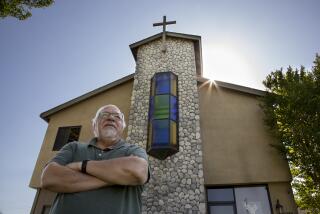Key Differences Among 3 Churches Emerge : Lutherans’ Merger Movement Hits Snags
- Share via
Four months before three Lutheran denominations are scheduled to vote on their merger into one church, what at first seemed to be a smooth road toward union has turned into one with potholes and caution flags.
Bishops of the 2.9-million-member Lutheran Church in America (LCA), the largest of the church bodies, say they want several major changes in the proposed constitution for the prospective 5.3-million Evangelical Lutheran Church in America.
Their complaints about the proposed constitution include, among other objections, that local congregations may be permitted too much autonomy, that the ordained ministry ranks will be undercut, that ecumenical relations will suffer and that a proposed quota system for assuring minority representation on church legislative bodies is rigid and legalistic.
‘Basic Difference’
Their recommended solutions were not characterized as “demands,” but Bishop Howard McCarney of the LCA’s Central Pennsylvania Synod said some parts of the constitution hammered out by the joint Commission for a New Lutheran Church last February reflected “points of basic difference” between the LCA and its merger partners.
The commission has one more scheduled meeting, June 23-25 in Seattle, before the three Lutheran bodies, the LCA, the 2.3-million-member American Lutheran Church (ALC) and the 110,000-member Assn. of Evangelical Lutheran Churches (AELC) vote on the merger during roughly concurrent conventions in late August. If the merger is approved, a constituting convention would be held next year and the the new church would be launched Jan. 1, 1988.
A spokesman for the ALC, Herb David, said he wondered whether the joint commission will be able to satisfy everyone in a three-day meeting. “We have come down to not much time,” David said.
“I think we will probably still approve it in August, but it will be a close vote,” noted the Rev. Stanley E. Olson of Los Angeles, who was one of 30 LCA regional bishops who convened late last week in the New York headquarters of the denomination and raised objections to the proposed constitution.
View Not Unanimous
“I hope there will be a whole lot of changes in Seattle, but the ALC (American Lutheran Church) Church Council meets in mid-May and I’m sure they will have as many things they want changed as we had,” Olson said.
The bishops’ view, however, is not unanimous within the LCA. Commission Chairman William Kinnison, an LCA executive council member, supports the proposed constitution and disparaged the objections by the bishops of his denomination. “The bishops of this church have given no vision for four years,” Kinnison told the Minneapolis Star and Tribune.
Likewise, commission member Albert Anderson, an ALC publishing executive, said he was “very disappointed” in the bishops’ statements. “I think they’re saying we must adopt the LCA view rather than the compromise reached by the commission, which includes members elected by the LCA,” Anderson said.
Headquarters Site Opposed
Many LCA officials, including Olson, are also unhappy with the commission’s compromise choice in February of Milwaukee as the headquarters city for the new church. Milwaukee, which was selected over Chicago and Minneapolis, has been criticized for its alleged small-city image.
“I cannot find too many people who are pleased with Milwaukee,” Olson said. Olson and other LCA officials have suggested that existing offices should be used instead, such as LCA publishing facilities in Philadelphia and the ALC headquarters complex in Minneapolis.
Citing what they termed their “basic” differences with the merger plan, the LCA bishops urged that the new church’s ecumenical commitment to Christian unity be “more fully articulated” and that the distinctiveness of the ordained ministry be restored. That puts the LCA at odds with the AELC, which considers parochial school teachers and deacons to be ministers.
Differences also remain among the three church bodies on contributions to the pension and benefits plan.
But two of the thorniest problems involve philosophical overtones--questions on the quota system of representation and on the relative authority of the national church and local congregations.
Quota Proposal
Under the present quota proposal, representatives to the churchwide assembly and membership on councils, boards and committees will be 60% lay and 40% clergy, and half of the lay representatives must be female. “People of color or (of) primary language other than English” will constitute 10% of the total. (Nationally, about 2% of the members of the merging churches are members of minority groups. Most members are of Scandinavian or German ethnicity.)
The same percentages for clergy/lay, male/female membership apply to regional, or “synod,” assemblies, councils, committees and boards, with 10% minority representation on these synod groups a goal to be reached within 10 years.
The editor of The Lutheran, the official LCA magazine, said his church has generally expressed displeasure with the methods, though not the intent, of including women and minorities on the boards and legislative bodies of the new church.
“Heavy sentiment encourages the churches to continue on their converging path,” editor Edgar Trexler wrote recently. “It’s unfortunate, though, that the path continues to be mined with the issue of quotas.”
The 70-member commission itself was formed along guidelines for clergy/lay, male/female and minority ratios. The panel rejected overwhelmingly two attempts in February to remove quota requirements for the new church. “It’s one of the better things the commission has come up with,” said the Rev. L. David Brown, the Iowa district president for the ALC.
On the congregational authority issue, the ALC traditionally places the source for authority in the local church while the LCA bishops reiterated their philosophy that “the authority of the congregation is derived from the whole church.”
The bishops proposed that within four years each local church adopt a model constitution acceptable to its regional body. The bishops also urged that a local church be allowed to sever its links with the larger church only with a two-thirds majority vote. Present plans would allow congregations to keep their former constitutions and to leave the denomination with a simple majority approval.
Timetable to Merger
The timetable for the formation of the Evangelical Lutheran Church of America began with approval in September, 1982, of negotiations toward merger by three denominations.
Now four months remain for working out compromises unless delays are approved.
- Commission for a New Lutheran Church (final meeting), Seattle, June 23-25.
- Final biennial conventions: American Lutheran Church, Minneapolis, Aug. 23-29. Assn. of Evangelical Lutheran Churches, Chicago, Aug. 26-28. Lutheran Church in America, Milwaukee, Aug. 25-Sept. 1.
- Constituting Convention, Columbus, Ohio, April 28-May 3,1987.
- Inauguration of new church, Jan. 1, 1988.
More to Read
Sign up for Essential California
The most important California stories and recommendations in your inbox every morning.
You may occasionally receive promotional content from the Los Angeles Times.













